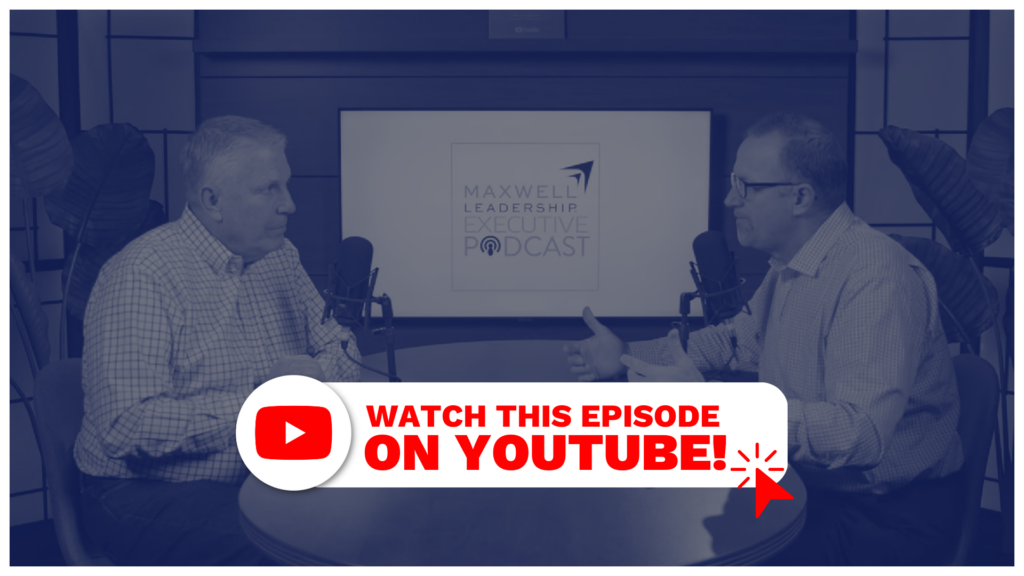Executive Podcast #255: Inspiring Leaders

Johann Wolfgang von Goethe eloquently described the power and influence of inspiring leaders when he wrote: “I have come to the frightening conclusion that I am the decisive element. It is my personal approach that creates the climate. It is my daily mood that makes the weather. I can be a tool of torture or an instrument of inspiration. I can humiliate or humor, hurt or heal.”
Have you considered how your mood, behaviors, and actions will influence others. Researchers Jack Zenger and Joe Folkman have studied inspiring leaders and marveled at their ability to create new attitudes and emotions in others.
Download our Learning Guide for this podcast!
Perry Holley:
Welcome to the Maxwell Leadership Executive Podcast, where our goal is to help you increase your reputation as a leader, increase your ability to influence others, and increase your ability to fully engage your team to deliver remarkable results. Hi, I’m Perry Holly, a Maxwell leadership, facilitator and coach.
Chris Goede:
And I’m Chris Goede, executive vice president with Maxwell Leadership. Welcome and thank you for joining. As we get started, I’d love for you to visit Maxwellleadership.com/podcast. There you can download the Learner guide and follow along with our lesson today as we kind of go through and talk about this. Also, if you’re interested in having one of our executive coaches or facilitators partner with you guys as you figure out how to enhance your culture, develop your leaders, you can fill out a form and we’ll get back in touch with you with that request. And love to talk about what that looks like and what the needs are there. Well, today’s topic is are you an inspiring leader? So I feel like on this episode, I need to sit up a little bit tighter. I need to get a little louder. You are an inspiring yes, I need to have a smile on my face. We’ll talk about that in just a little bit. But did you know, Perry, that your mood, your behavior, your actions can negatively or positively affect the team? I did know that. You did the as you say, people are watching you all the time, right? All the time. Well, researchers Jack Zanger and Joe Fulkman have studied inspiring leaders and marveled at their ability to create new attitude and emotions in others. And so today that’s what we’re going to talk about. We’re going to talk about some of the characteristics that come from their research and how we go about doing this.
Perry Holley:
I love this. There’s a quote I loved that affected me. That was by Johann Wolfgang von Goethe that talked about the influence of inspiring leaders. I used on the coaching call this week that I’ve come to the frightening conclusion that I am the decisive element. It’s my personal approach that creates the climate. It is the daily mood that makes the weather. I can be a tool of torture or an instrument of inspiration. I can humiliate or humor, hurt or heal. I thought, man, isn’t that the truth, is that we teach a lesson. I have been teaching it for quite a while now, but you’re always making people feel something. What are you making people feel, and is it intentional? And I love this. And the thought today was, can we share some ideas based on the research from Zinger and Folkman that I found fascinating, that can get practical on how exactly I can demonstrate more of these inspiring characteristics? So I’ll just jump right in. Number one was that they said that inspiring leaders foster optimism and hope. And I know in today’s climate and environment and just the challenge of so many things going on that can be a pretty big, heavy one to start with. But optimism and hope. Yeah.
Chris Goede:
When you say that, there’s three things that come to mind that I just want to encourage our leaders and our listeners to think about when it comes to this part of being able to inspire their people and their team with that hope and the optimism. Number one is having an attitude of gratitude yourself, right? You often hear about these people that do gratitude journals at night or in the morning or whatever it might be. But it’s interesting because as you journal those, as you think about those, as you document them, it changes, right? It changes your behavior and then your energy. And so I think that’s huge. The other thing is I think you can do this by seeing possibilities in every situation. There are a lot of negative situations that happen on a daily basis in organizations and in our world, but we’ve got to have a lens if we want to think about this and inspiring hope in people as we got to think about what are the possibilities in every situation that we come across. The final one is, and I’m pretty sure you told me this story, I don’t talk to anybody else but you. But was, man, we just got to smile. Mind your face. Yeah. And I think it was you that talked about sometimes you’ll go into airports and you will intentionally look at somebody walking by, and you will smile almost uncomfortably and get in the way till you get them to look at you and smile back. And it’s a fascinating exercise because I’ll do it too, now, and I’ll even smile and say, hey, how’s it going? And sometimes I don’t get any response, and they walk by and go, okay, well, good. It’s nice talking to you. Did I know that right? Sometimes you see them light up a little bit. And so I love when you talked about that, because that is something that’s a shift, right? That’s a change that when we smile, there’s a little bit of optimism and hope. And so as leaders, I would encourage you to do that.
Perry Holley:
Trying to greet people in elevators. When I get in the elevator, say, Good morning, how are you? The craziest place in the world. I know, and everybody’s looking like they’re going to an execution on the 21st floor. I go, no, you can actually make people feel something.
Chris Goede:
I wonder if some of our team members feel like our team culture and environment is an elevator. That’s the next topic. We’re giving you all kinds of titles. Futuristically, we’re going to have an Elevator is going to be in our title. Watch this coming. But, yeah, it’s interesting, right? It’s a place where people put their head down and you can just feel it, right? There’s no inspiration in that.
Perry Holley:
Number two from the research said that inspiring leaders build resilience in others. I got to tell you, this one kind of took me back and go, I don’t think of myself as responsible or capable or even thinking about building resilience in others. But I’d love to hear what you think about this, because I’ve been thinking about it a bit and I wonder, how do you see that one?
Chris Goede:
Boy, I tell you, this is something one of our thought leaders, Valerie Burton, studies a ton about this. And we’re in talks right now about. Should that be a content piece that we help teams with? Because in the day and age of which we are living and working, this is something that as leaders, we need to be very aware of if we want to inspire our team. I think when I think about this resilience and some of the conversations I’ve had with her, and I think you’ve even looked at some of her stuff in the past around this. As leaders, if we will help our team develop a growth mindset, they’ll become more resilient. And I think if you lead with that and you challenge them, you become that inspiring leader, right? You help them in this resilience side of things, be able to do that. The other thing is, I would say is as you create resilience in people is give opportunities for innovation themselves, but then also you demonstrate and create innovation in whatever you’re working on. And it helps the from a mindset shift build that resilience in each other. And so it’s interesting because a lot of the conversations we’re talking about, even just in the beginning couple of minutes here, tie back to a couple of episodes ago on our podcast. We talked about going from a boss to a leader, and we talked a lot about the inspiring part of that. Everything that we’re giving you from a practical application and what we’re talking about, we don’t want it to be fluff, we don’t want it to be fake. Inspiring people is a big deal as a leader, but there are some tactical ways to go about doing it. And so I think one of those is to help people become more resilient to what’s going on in the world around us.
Maxwell Leadership Growth Plan Ad:
Leaders, you know better than anyone that growth is essential if you want to make tomorrow better than today. But fitting growth into your calendar takes intentionality and self discipline. So let Maxwell Leadership help make your growth achievable. You’re invited to join thousands of worldwide leaders in using the Maxwell Leadership Growth Plan. The Maxwell Leadership Growth Plan provides you with convenient and easy to implement leadership resources, including video lessons from John Maxwell, all at your fingertips, available in our Maxwell Leadership app or online, you’ll be coached by many well known leadership experts that will help you achieve your growth goals. You can even listen to this podcast right there in the app. Check it out for free today at Growth.MaxwellLeadership.com. That’s Growth.MaxwellLeadership.com.
Perry Holley:
I think about resilience is really bouncing back from setback or failure. It’s really plowing through a hard time and coming out stronger however you want to see resilience. But I love that. What is my role as a leader in that is helping you with perspective? I mean, I remember John Maxwell when we got into 2020 and the COVID and he said that perspective is going to really determine how you come out of this hard thing, is that perspective is how you view things, determines how you do things. And that really struck with me that, yes, I can. And you hear a lot of people, the worst thing ever, we’re doomed, we’re going to die. And then they suffered. And I thought, it is tough. Don’t deny the struggle, but fight through the struggle. And I just saw a proverb, I can’t remember which culture has it, but it said I kept hearing people on my team saying, if we can just get past this next big thing, if we can just get past this next big thing. And the proverb said, behind this mountain are more mountains. It doesn’t necessarily get easier. Don’t set yourself up to it’ll be easier when I get past this thing. Set yourself up. And you’ve heard me say, this is one thing that really affected me, was stop wishing things were easier, wish I was better. And that was a Jim Rohn quote that said, I found myself thinking, I can’t get through this. This is so hard. I don’t want to stop wishing it was easier, wish you were better. And so, yeah, you can help your people have a growth mindset determined to pick themselves up and try again, helping them to pick themselves up and try again, encouraging them to try again, to keep moving, and that there’s going to be ups and days and the are going to be down days.
Chris Goede:
Another real quick thing before you move on to the number three. Another part of this resilience, which is interesting, and I kind of have a smile as I’m getting ready to say this. I might get struck by lightning, but one of the things it was talking about in resilience is the ability to help your people create balance. And I say that because that’s hard. It’s hard for me to do, but I need to do a better job of it. As you do that, they become more resilient to other areas of their life if they’re equally balanced versus all in on one part of their life. So I just want to throw that in there. As you were talking, it reminded me about that.
Perry Holley:
We have a podcast on resilience. It’s been quite a while back, but I don’t have that number in my head. But it’s a big deal for leaders, one for themselves, and then help. I didn’t think about it as being an inspiring leader. You do inspire me when you help me plow through where my struggle is. Yeah, I love that. Number three, zinger Falkman on the research said that inspiring leaders ignite initiative in their teams, you ignite initiative. So getting people to take initiative and I just have heard John say that leaders initiate and inspiring leaders get their teams to initiate and that you don’t sit back and wait. You don’t wait for things to happen before you respond. You initiate and ignite this initiative. Taking in other people. I don’t know if you see that much in how you lead the team.
Chris Goede:
Yeah. Not only I’m going to speak about not just on how I tried to lead the team, but how I like to be led at times. And I wrote down a couple of things here, which is, man, if you can reveal to me what’s at stake and I can get in alignment with that, that is going to initiate me in many, many ways. It’s going to ignite that passion if you can reveal what’s at stake. The other thing is, again, going back to the power of asking questions, right? If you begin to ask questions and you begin to allow me to speak into what potential solutions could be, potential problems could be like, be a part of it, that is going to ignite that initiative in me as a leader. And then the other thing is, when I think about this in my own past experience and how I’ve been led, which is I’ve had people literally say, man, can I have your commitment that we’re going to get this done? Now, listen, when you say the word commitment to me, right, I’ll be committed and I’m going to go after it. Or, as we say, our body will be leaning in that direction as we fall over. But if they ask for my commitment and the in the past, I’ve had them not only ask for my commitment in certain things, but then they check in and they hold me accountable to that. Those couple of things I just shared with you, again, from a personal experience, not how I lead, but how I’ve been led. Now, again, I probably lead that way at times because of how I’ve been led in the past. But those are a couple of things that come to mind when I think about, man, what drove initiative in me from people that have led me in the past.
Perry Holley:
I think just expecting that I’m not going to provide every answer to you, the people on my team. I expect you to initiate and to plow forward and to challenge, make me move in the right direction. Number four was inspiring leaders help others embrace responsibility. So thinking about, as a leader, can I help my team take ownership and take responsibility for what they have? My brain kind of went to accountability here. Is that the same thing? But I think responsibility and taking ownership on their own is that I inspire you to want to be responsible for your part of the business.
Chris Goede:
Yeah. I have this little phrase that I use periodically that is individual responsibility, collective pride. Right? So a team is made up of a bunch of individuals. And so we need to be responsible for what our KPIs are, what people are asking our commitment for. We need to be responsible. And so how do we embrace that? What does that look like? Wrote down a couple of things here I’ll share with you. Number one, I think when you talk about responsibility is we got to get clear on the front end what those expectations are. What is it that Perry needs me to be responsible for in order for this to happen and then document them? Because I think we all have a tendency to forget what was said. And I’ve had some conversations with Sarah. My wife wasn’t documented, so I didn’t hear it right. I didn’t say it right. So we’ve all had those conversations with people that we work with or our significant others. And so set those clear expectations and then document them, I think helps drive responsibility in people. And then the other thing is, it’s okay to embrace failure and mistakes. There’s a lot being said and talked about this, and John’s written a couple of books about that. But I think when you are okay with that as a leader and you set that as the culture and the environment, people will take responsibility. They’ll be like, you know what? I’m responsible for that, and I messed up. Or, I’m responsible for that and we’re still working on it, or because they know that man making a mistake is not a fatal flaw. And there’s a difference between mistakes and fatal flaw inside organizations. And so as you’re inspiring people, allow that to happen, because then you’ll get people that want to really take more and more responsible, responsibleness of certain things the organization is working on.
Perry Holley:
Number five was inspiring leaders. This is from the research. Inspiring leaders. Spread enthusiasm. And I wondered if this was being the cheerleader for the team, the CEO, the chief encouragement officer, how do you see our responsibility as leadership to inspiring leaders to spread enthusiasm?
Chris Goede:
Yeah, I think this is contagious. Right? And so it is our responsibility. We were talking a little bit as we got started here about just smiling. Now, that’s not enthusiasm. That’s not being the cheerleader, but it’s the beginning stages of it. Let me ask you this. How many times have you been watching a college football game and the camera goes to the cheerleaders and they’re not smiling? I hadn’t thought about that to this conversation, but I don’t know ever. Now, I’m not going to be able to not watch a college football game this summer or this fall. And when it goes to the cheerleaders, I’m going to be like, oh, they’re all smiling. Matter of fact, it almost looks like they’re fake smiling, but they’re smiling. So it’s part of that. But so much is communicated in body language. I don’t know the percentage right off the top of my head. You may know, but when it talks about how we communicate, the majority of that is in our body language. Some of it’s tone, some of it are the words, but the majority of it is a body language. And so in order for us to spread that, we’ve got to be modeling that people are going to do what they see. And so we’ve got to be leading that as leaders.
Perry Holley:
I used to say, eieo, energy in, energy out. Good is what I’m going to put in. I’m going to get back. People are watching. If you’re not enthusiastic and energized by what’s going on, people are probably not going to follow you.
Chris Goede:
Yeah.
Perry Holley:
And finally, last one, inspiring leaders. I love this. Create confidence in others. To me, I just think about do people on your team know that you believe in them? Do the feel that you have belief in them? Do they feel you’re confident in them? So they carry that confidence versus the other side of that, which I don’t believe in you. And I feel like I’m always trying to catch up yeah.
Chris Goede:
In the world of which we live right now. I was talking about this to a group the other day about belief deficit. You and I were talking about this around teamwork, and one of the points that I talked about was the power of belief and how there is a massive belief deficit not only in ourselves and individuals, but I think there’s a belief deficit in leaders and of their teams. And so we need to be aware of that. When I think about this, the first thing I think about is we are notoriously going to have people in our circle of influence and on our team that do not have enough confidence. They don’t have any self confidence. They may put up a front. You need to understand that. You need to look behind that. But they may have hardly any confidence, even though they are accomplishing things and doing things. And as leader, you need to be aware of that and you need to help create and bring out that confidence. It won’t look the same as in every one of your team members, but there is a way for you to improve and help people with their self confidence. The last thing I’ll leave you with as I kind of wrap up and throw it back to you in regards to this is we have to balance as leaders. We have some people on our team that we’ve led where they might have some overconfidence.
Perry Holley:
I figured I’d get a little laugh out of you.
Chris Goede:
That came out of nowhere. Right. So I think that we want to make sure that we are balancing the self confidence that we’re in people and then maybe turning down the dial. Andy Stanley wrote a book a long time ago that really changed the way that Sarah and I parented, and he talked about a to. I think it was PG about parenting. And it talked about, hey, sometimes you got to turn the dial up and sometimes you got to turn the dial down. And you need to be aware of that. And I think it’s the same thing with confidence here. So as an inspiring leader, here’s why I wrap up with this. As an aspiring leader in this particular point, you need to be aware of that, because those that maybe have a little bit too much are going to squelch the ones that don’t. And it’s your job to not only inspire that individual, but to also inspire the team as a collective unit. And so we need to be focused on that.
Perry Holley:
That’s funny. Well, just thanks to Jack Zinger and Joe Fulton, the research and it inspired me as I was reading it, and I’ve worked with those guys in the past and know that that’s really some solid stuff. So hope it’ll encourage you as you develop your inspiring leadership style to bring your team together. Just a reminder, if you want the Learner guide for this episode, if you’d like to leave us a comment or a question, we’d love hearing from you. You can also learn about our offerings. That all that is maxwellleadership.com/podcast. We love hearing from you. Very grateful you’d spend this time with us. That’s all today from the Maxwell Leadership executive podcast. Sam.
To be a Successful Leader, You Need Feedback on Your Leadership.
We’re excited to announce our new and improved Organizational Effectiveness Survey (OES). The OES gathers feedback from employees to give leaders and management the knowledge and action plans needed to develop a more effective and productive work environment. Our new version measures 4 areas of your business: Leadership, People, Strategy, and Performance.













Be the first to comment on "Executive Podcast #255: Inspiring Leaders"